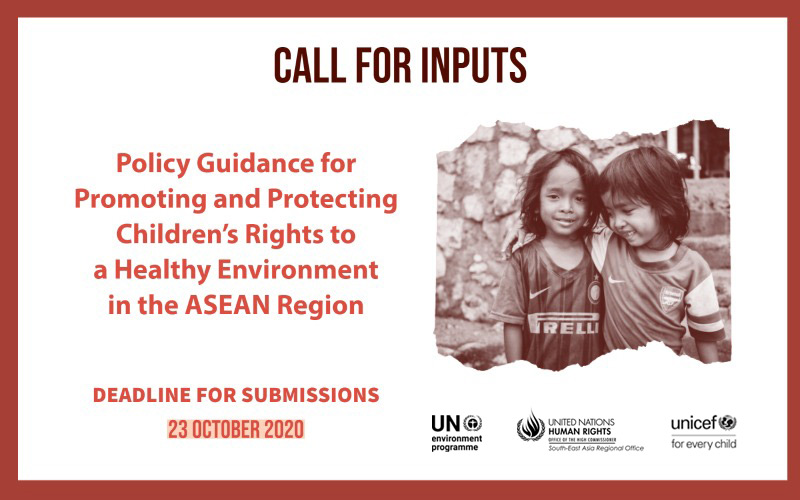CALL FOR INPUTS
Policy Guidance for Promoting and Protecting Children’s Rights to a Healthy Environment in the ASEAN Region
Deadline: 23 October 2020
The regional offices of the UN Children’s Fund (UNICEF), UN Environment Programme (UNEP), and UN Human Rights (OHCHR) jointly launched an initiative to develop regional guidance in South-East Asia for promoting and protecting children’s rights to a healthy environment. The purpose is to identify, clarify, and consolidate policy guidance which governments, civil society, businesses, and children in Member States of the Association of Southeast Asian Nations (ASEAN) can use to advance efforts to incorporate children’s rights to a healthy environment in policies, legal frameworks, and operational guidelines to strengthen awareness of, and further reinforce the political will to protect, children’s rights to a healthy environment.
UNICEF, UNEP, and OHCHR welcome inputs from ASEAN Member States and ASEAN inter-governmental entities, national human rights institutions, civil society actors, humanitarian and development organizations, business representatives, and other stakeholders in the ASEAN region to contribute to finalizing the guiding principles and providing input for guidance on implementing the principles.
Background
In 2018, the United Nations Special Rapporteur on Human Rights and Environment (the Special Rapporteur) submitted a report to the Human Rights Council on the relationship between children’s rights and environmental protection. The Children’s Environmental Rights Initiative (CERI), created under the auspices of the Special Rapporteur, UNEP, UNICEF and six other core partners, characterized the challenge for children’s rights and environmental protection as a lack of both clear normative and practical guidance on applying child rights in the environmental context. One of the most fundamental obstacles to the effective protection of children against environmental harm is a general lack of awareness of the many links between a safe and healthy environment on the one hand, and children’s rights on the other. Those concerned with children’s rights and those who protect the environment often focus on one topic to the exclusion of the other. As a consequence, children’s rights tend to be overlooked in decision-making on the environment, which leads to adverse outcomes in terms of their health, development, and opportunities in life.
At the 44th session of the Human Rights Council on 1 July 2020, which included panel discussions on realizing the rights of the child through a healthy environment, many States requested guidance on how to support children’s rights to a healthy environment and involve children in decision-making processes, and particularly on how to do that at the regional level.
ASEAN has laid the foundation for a regional approach to children’s rights to a healthy environment. All ASEAN Member States are Parties to the Convention on the Rights of the Child and also to key multilateral environmental agreements (MEAs). ASEAN has already adopted three declarations that have provisions pertaining to children’s rights to a healthy environment. However, there has been no comprehensive policy guidance to date for ASEAN governments and regional actors on this issue.
Against this background, UNEP and UNICEF joined with OHCHR to convene a regional Virtual Expert Group Meeting, on 15, 16, and 23 July 2020, to develop policy guidance for promoting and protecting children’s rights to a healthy environment in ASEAN. The objectives of that meeting were to: (a) identify a common understanding among experts in ASEAN Member States on policy guidance for laying the foundation for promoting and protecting children’s rights to a healthy environment in the ASEAN region; (b) draft guiding principles; and (c) provide the basis for UNICEF, UNEP, OHCHR and ASEAN stakeholders to strengthen awareness of children’s rights to a healthy environment and further reinforce the political will to protect them.
The output of the Virtual Expert Group Meeting was a draft of 37 guiding principles for children’s rights to a safe, clean, healthy and sustainable environment in ASEAN. The guiding principles will form Part I of a policy guidance document that will also provide, in Part II, direction for children, the public and private sectors, civil society organisations, and the media to assist them in applying the guiding principles.
Questionnaires
UNICEF EAPRO, UNEP ROAP, and UN Human Rights SEARO are interested in receiving inputs on:
- Part I: The draft guiding principles; and
- Part II: Measures that are needed to implement and achieve the purpose of the guiding principles.
Please use this link or the button below to provide comments and input on each of the parts of the policy guidance. Please provide submissions though the link by 23 October 2020.
Unless requested otherwise, the submissions may be used, in part or in full, in the final version of the guiding principles and in the guidance on measures needed to implement and achieve the purpose of the guiding principles.
For any questions or clarifications, please do not hesitate to contact UNICEF, UNEP, and/or OHCHR by email at pmoore@unicef.org.

